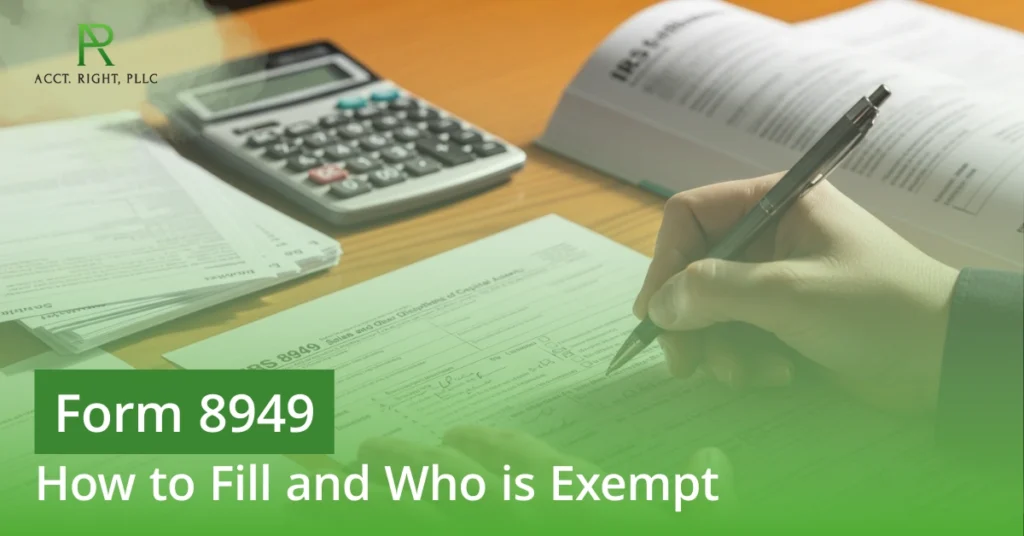
Supporting Schedule D, Form 8949 is used to report sales and exchanges of capital assets (capital gains or capital losses) like stocks, bonds, mutual funds, or real estate (other than most primary residences). This form consists of Part 1, which is meant for denoting short-term capital gains or capital losses, and Part 2, which is meant for denoting long-term capital gains or capital losses.
Taxpayers must complete Form 8949 before carrying the totals over to Schedule D, where the overall capital gains and losses are calculated. Schedule D is the summary form for overall gains/losses, while Form 8949 is the detailed listing.
Form 8949 gives a breakout of short-term and long-term capital transactions, allowing the IRS to match what you report with your Forms 1099-B or 1099-S from brokers or financial institutions.
Who Must File Form 8949?
According to the IRS:
- Individuals, corporations, partnerships, estates, and trusts that sold capital assets during the year.
- Sole proprietors must file if they sold any capital assets for a gain or loss.
Example: You are a sole proprietor and sold stocks, cryptocurrency, or business property held for investment. You report those sales here.
Note: Ordinary business income (from services/products) is not reported on Form 8949; it goes on Schedule C. Only capital gains/losses are reported.
Summary: Any business type can need Form 8949 if it sells capital assets. Sole proprietors are included but only for capital gains/losses, not regular income.
When to Submit Form 8949
- Form 8949 is filed with your annual tax return:
– Individuals: Form 1040
– Corporations: Form 1120
– Estates/Trusts: Form 1041 - Deadline: Same as your income tax return — usually April 15; however, depending on your status, an extension may be requested afterwards.
- If you miss the deadline:
– Penalties may apply for failure to file or failure to pay taxes owed.
– IRS may also flag mismatched 1099-B information.
Is Form 8949 Submitted as a Secondary Form?
Yes, Form 8949 is a supporting form for Schedule D:
- Form 8949: Reports each individual sale with details.
- Schedule D: Summarizes short-term and long-term totals from Form 8949 and calculates net gain/loss.
- Form 1040/1120/1041: The totals flow into your main return.
Want a smooth accounting and taxation journey while you focus solely on your business?
Let Acct. Right. PLLC handle it all for you.
Parts of Form 8949
According to the IRIS, Form 8949 has two main parts:
| Part | Type of Asset Sale | Held For | Boxes for Adjustment |
| Part I | Short-term | 1 year or less | A, B, or C |
| Part II | Long-term | More than 1 year | D, E, or F |
Step-by-Step Guide For Filing Form 8949
Step 1: Gather Information
You need:
- Form 1099-B (from brokers)
- Form 1099-S (for real estate sales)
- Purchase date & price
- Sale date & proceeds
- Any adjustments (wash sales, corrections, etc.)
Step 2: Identify Short-term vs Long-term
- Short-term: Held ≤ 1 year → Part I
- Long-term: Held > 1 year → Part II
Step 3: Check the Correct Box
You need to check one of the three options in each part of the form. Read out the options carefully before checking any.
Part I (Short-term) – Boxes a, b, c
- Box A: Cost basis reported to IRS and correct
- Box B: Cost basis not reported to IRS
- Box C: Any adjustments required
Part II (Long-term) – Boxes d, e, f
- Box D: Cost basis reported and correct
- Box E: Cost basis not reported
- Box F: Adjustments needed
Tip: Compare your Form 1099-B column “Cost or other basis” and “Check if basis reported to IRS.”
For detailed instructions, please proceed to the instructions for Form 8949 from the IRS.
Step 4: Fill Out Columns
Each row must include:
- (a) Description of property – e.g., 100 shares of XYZ Corp
- (b) Date acquired – MM/DD/YYYY
- (c) Date sold or disposed – MM/DD/YYYY
- (d) Sales price – Total proceeds
- (e) Cost or other basis – What you paid
- (f) Code(s) for adjustments – W = wash sale, O = other
- (g) Adjustment amount – If any
- (h) Gain or loss – Subtract (e)+(g) from (d)
Important: All columns should be filled where applicable. If there is no adjustment, leave (f) and (g) blank.
Step 5: Calculate Totals
- Sum columns (d), (e), (g), (h) for each part separately
- Transfer totals to Schedule D:
– Part I totals → Schedule D, line 1 (short-term)
– Part II totals → Schedule D, line 8 (long-term)
Step 6: Attach Form 8949
- Attach the filled Form 8949 to your tax return.
- If using software, this is often done automatically when importing 1099-B/S data.
Note: While Form 8949 is used to report capital gains and losses, taxpayers who need additional time to file Form 8949 may submit Form 7004 to request an automatic extension for filing certain information returns, including those that report transactions affecting capital gains and losses
Form 8949 Exemption
Here we have only highlighted a few exemption criteria; for a Complete list and instructions for Form 8949, please visit the IRS site here and look for Exception 1 and Exception 2.
| Criteria | Action Required |
| Received a Form 1099-B (or substitute statement) showing basis was reported to the IRS, with no adjustments or codes in boxes 1g or 1f. | Report directly on Schedule D (lines 1a or 8a) — no Form 8949 needed. |
| You’re a corporation filing Form 1120-S, a partnership filing Form 1065, or an exempt entity, and have more than five transactions to report. | You can use summary totals with special formatting instead of submitting each transaction on Form 8949. |
IRS has put Form 8949 exemptions under 2 categories, Exception 1 and Exception 2. Entities qualifying for both exemptions may opt for both and record their transactions accordingly. A link to complete IRS instructions for Form 8949 can be found above.
Key Notes for Beginners
- Form 8949 is only for capital gains/losses, not ordinary business income.
- Missing the form or errors can trigger IRS notices or penalties.
- Keep all 1099s and records in case of an audit.
- If unsure, a tax preparer like Acct. Right, PLLC can save headaches.
Disclaimer: This blog is for informational purposes only and does not constitute medical, legal, or professional advice. While we strive for accuracy, errors or omissions may occur.




